Epping Forest
Epping Forest is an area of ancient woodland, meaning
forest that has existed since pre-historic times without being felled. It's
estimated by the Woodland Trust
that only 2% of Britain is covered by ancient woodland, and most of this is
fragmented, so Epping Forest is one of the largest remaining areas in the
country. The forest covers about 10 square miles, big enough to feel quite wild
in places, despite being close to London. It was saved from destruction by an
act of parliament in 1878 and put in the care of the City of London Corporation. There are no restrictions on access, there's plenty of free
parking, and any pictures taken here can be sold or published freely.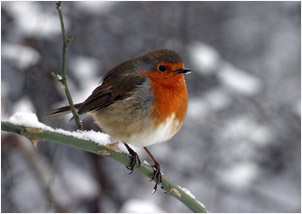
I have lived in the Epping Forest area for many years and have taken thousands of shots here. I'm still finding new things to photograph and add to the portfolio. This year in February we had the heaviest snowfall in London for 20 years, giving a new look to everything in the forest. In the summer I was shooting wildlife, and I have been busy with the macro lens in recent weeks as the mushrooms appear ( there is a separate article about that here ).
I won't attempt to draw a map of the area. Instead you could display the Google Maps aerial view. There is also a map at the City of London Corporation forest webpage.
Chingford Plain and around
At the southern end of the main contiguous area of the forest is Chingford Plain. Chingford public golf course sits on the western side. Maintenance of the course gives this part of the plain a manicured look. There are usually a few golfers and dog walkers about. Walkers ( and photographers ) have the right to access the course since it is part of Epping Forest, but are not supposed to interfere with play. In fine weather the eastern side of Chingford Plain attracts lots of people - riding horses, flying model aircraft, picnicking and sunbathing. The area is so large though that it never feels crowded, and the quiet of the woods is only a few paces away.
Further west beyond the plain, the ground rises to Pole Hill where there is an obelisk marking the Greenwich meridian. There is a view all the way to central London from here. Heading north from Pole Hill, a path drops down behind the golf course into a deep valley and then up again to the grassy slopes of Yardley Hill. This is a nice quiet spot for a picnic, with unobstructed views over the Lea Valley reservoirs. A telephoto shot from here shows the London skyline with the gherkin ( the Swiss Re building ) in the east, the dome of St Paul's, and to the west to the Post Office Tower. To the north of Yardley Hill, a path leads to Gilwell Park, the worldwide headquarters of the scout movement.
To the south Chingford plain rises sharply to a small hill on which sits Queen Elizabeth's Hunting Lodge. The building dates from 1543 and was once used by the royals to view the hunt. There is indeed a fine view of the forest from here. The Hunting Lodge sits in a small fenced area of land and getting a satisfactory angle on it is difficult. The addition of some people in period dress would bring the scene alive, and there might be an opportunity to get that shot at one of the events organised at the lodge ( more information is here ). Nearby is Butler's Retreat, originally a farm building but more recently a tea shop. A while after I took the picture below, lit here by winter sun, the tea shop went bankrupt and the place was boarded up and has not looked so good. The depressed owner went berserk and killed somebody, an incident reported here by the daily mail.

Butler's Retreat
Monk Wood
The central section of the forest is bounded by the Epping New Road ( the A104 ), Golding's Hill and Earl's Path. On the maps the name Monk Wood is shown here. A number of small streams cut through the woods in steep-sided valleys. The hilly nature of the area is best appreciated in winter when the moss-covered slopes are visible through the trees.
Monk Wood contains the iron-age earthworks of Loughton Camp. I find it surprising that after centuries of erosion by the weather, and many generations of trees growing and falling, the banks of Loughton Camp are still so clearly visible. The earthworks is not near a horse-ride so this is a quiet spot and a nice place to reflect. A focal point for an image of the camp is hard to find though. Snowfall blown against the slopes shows them up well, and on summer evenings light hits the banks from the west. At other times it can seem frustrating that an interesting and atmospheric place just doesn't sit well for the camera.
Below the earthworks is Loughton Brook Valley which runs south-east into the town. The stream is the largest in the forest and has cut a deep channel, although there never seems to be that much water flowing. We had a fine autumn in 2002 when I captured the shot below. I returned to this location recently to see if I could improve on the shot but it doesn't look as good now. Everything in the forest is gradually changing, as trees grow and wither, so a shot you find one year will probably never be quite the same again.
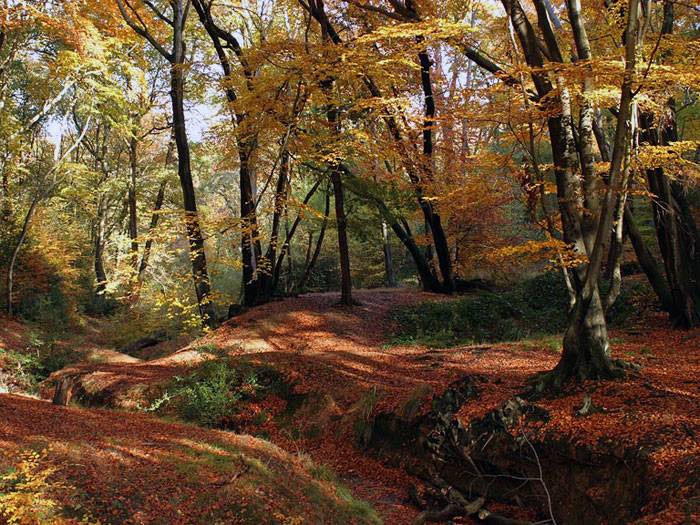
autumn in Loughton Brook Valley
The Green Ride runs north-south through Monk Wood and delivers a stream of horse-riders, walkers and cyclists into view. The ground rises and falls steeply, and the ride twists and turns through the woods. There are many good vantage points here.
The Wake Valley pond is actually on the High Beach side of the Epping New Road, but I will include it in this section since it is difficult to get to from High Beach. It has a different character from Connaught Water, being smaller and more sheltered, with fewer birds, but with reeds and water lily growing on the water's edge. I have seen a turtle here too, basking on a floating log. There are several smaller ponds that I usually visit when I am walking, such as Blackweir Pond which enjoys a quiet spot away from the main paths.
Connaught Water
Connaught Water is the largest lake in Epping Forest. It is an artificial
lake created in the Victorian period from a marshy area. The architects cleverly placed three
islands within the lake and these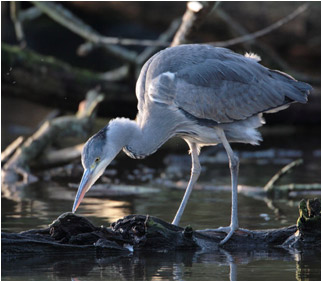 create a number of interesting visual angles,
and provide a safe haven for nesting birds. The lake supports a large bird
population all year round, dominated by the canada geese and
mallards. I look out for swans, heron and robins. In late spring the young birds
hatch and it's possible to get close to the ducklings, goslings and cygnets.
They grow quickly so the optimum time may only last a week or two. At this time
of year there is often some flooding and still shallow pools form in areas by
the lake. Although the flooding it is nuisance to walkers the birds seem to like
it and there are lots of angles and reflections for photographers.
create a number of interesting visual angles,
and provide a safe haven for nesting birds. The lake supports a large bird
population all year round, dominated by the canada geese and
mallards. I look out for swans, heron and robins. In late spring the young birds
hatch and it's possible to get close to the ducklings, goslings and cygnets.
They grow quickly so the optimum time may only last a week or two. At this time
of year there is often some flooding and still shallow pools form in areas by
the lake. Although the flooding it is nuisance to walkers the birds seem to like
it and there are lots of angles and reflections for photographers.
The lake gets quite busy with visitors at weekends. An early morning visit will be quieter and give more chance of reflections in still water. After a cold spell in winter Connaught Water freezes over and looks quite different. The birds are forced to skate on the ice and a few foolish people try their luck too. Every few years ( 2009 was one ) snow settles on the ice and then we get a real transformation of the landscape. It's a shame we don't get more snow in London.
around Copped Hall
Copped Hall is an 18th century stately home that was gutted by
fire in 1917, while the house was being used as an army hospital. It seems the
army never offered to repair the damage and the owners couldn't
afford it, so the building remains a ruin to this
day. The original gates to the estate are on Crown Hill. The land between Crown
Hill and the M25 motorway, known as the Warren Plantation, is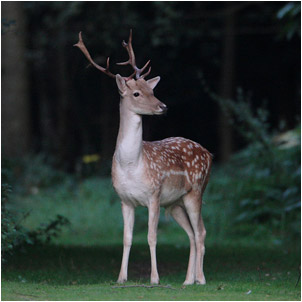 now part of the
forest. The pine trees here are not native
plants and they give the area a different look to the rest of the forest, with
the their straight regular trunks. The year-round cover of the rhododendrons and
the adjacent grazing land make this a favorite area for the fallow deer.
Unfortunately the roar of the motorway is ever-present. Crossing the bridge over
the M25, Copped Hall comes into view with its landscaped grounds. Deer often
graze here, normally keeping to the margins near the woods, but occasionally
running in a herd across the open fields. Walking north, the sound of the road
fades and the area merges into the Essex countryside.
now part of the
forest. The pine trees here are not native
plants and they give the area a different look to the rest of the forest, with
the their straight regular trunks. The year-round cover of the rhododendrons and
the adjacent grazing land make this a favorite area for the fallow deer.
Unfortunately the roar of the motorway is ever-present. Crossing the bridge over
the M25, Copped Hall comes into view with its landscaped grounds. Deer often
graze here, normally keeping to the margins near the woods, but occasionally
running in a herd across the open fields. Walking north, the sound of the road
fades and the area merges into the Essex countryside.
around High Beach
Epping Forest sits on a ridge between the Lea and Roding valleys, and from the village green at High Beach you can see for miles to the west over the Lea. The village consists largely of a tea hut and a pub but it gets very busy at weekends. The church is a few hundred yards to the south, and this is one of my favourite spots. The churchyard is entirely surrounded by forest, creating a particularly peaceful and secluded atmosphere. It has some older gravestones and statuary and wild flowers in spring. The church faces south and is nicely lit by sun at all times of the year.
On Sundays the car park at the top of Fairmead Road is used as a meeting place for bikers. Writing this I realise I don't have a picture of their gathering. Normally I am aggravated by the ear-splitting noise of their exhausts and keep away. From a documentary point of view though, there is the potential for a good shot there. The horse rides around High Beach have some steep slopes similar to those in Monk Wood and also offer fine perspectives.
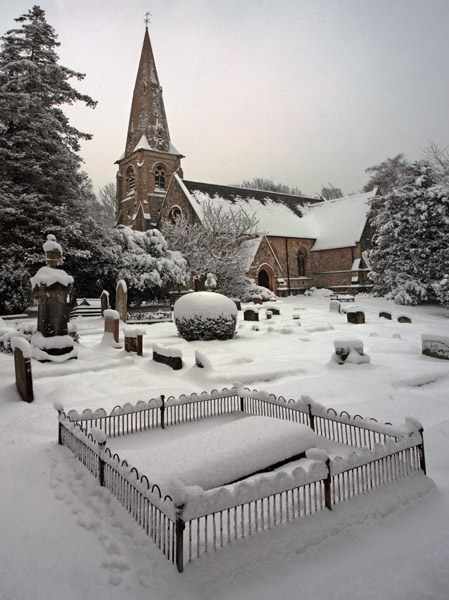
Church of the Holy Innocents, High Beach
towards Theydon Bois
The north-eastern section of the forest has the attractive
village of Theydon Bois to the east, Epping to the north, and Golding's Hill in
Loughton to the south. The road linking the A104 to Theydon Bois, Jack's Hill,
runs through the middle and provides a convenient car park. If you are walking
up from Loughton, the Green
Ride runs all the way to Bell Common in Epping.
Loughton, the Green
Ride runs all the way to Bell Common in Epping.
The area to the south of Jack's Hill is known as the Ditches. There is a deer sanctuary adjoining, on the eastern edge of the forest near Theydon Bois. It is surrounded by a high fence and is not open to the public, but I think you can get in with special permission. A herd of about 100 black fallow deer is captive there. The black fallow (inset) is associated with Epping Forest and apparently is quite rare in other parts of the country. I'm not sure how this came about since the different fallow varieties ( black, common, white and menil ) intermix and seem capable of covering large distances. The deer sanctuary was set up in 1959 to preserve them. Ironically the keepers shoot deer in the 'sanctuary' to keep the numbers down. I would have thought releasing them back into the forest would be a better idea.
Most of the wild forest deer now seem to be common fallow (
chestnut with white spots ) with a few black ones in the herds. Fallow
deer stay mostly on the northern margins of the forest, but I have seen a few
grazing in the furze ground ( between Jack's Hill and Golding's Hill ), and a
group at High Beach which were running and looked harassed. I think there are
too many
 people, dogs and cars in
the central and southern parts of the forest for the deer to be comfortable, and
they get chased out towards the quieter Essex farmland.
people, dogs and cars in
the central and southern parts of the forest for the deer to be comfortable, and
they get chased out towards the quieter Essex farmland.
The valley known as Hangboy Slade runs though the Ditches. The stream rises on the southern side of Jacks Hill just west of the Green Ride, in a boggy area covered by horsetails. The valley deepens and enters the open area of the Furze Ground. There is a particularly fine stand of silver birches here ( inset left ). The birch tends to colonise open spaces, but eventually gets displaced by the longer lived beech and oak - or by the forest keepers felling them too keep the deer glades open. I like the silver birch though, particularly when the leaves start to turn in October, a few weeks earlier than the predominant beech. The valley continues down, crossing the Green Ride, and leaving the forest at Debden Green. The steep sides of the valley combined with a few open spaces allow some nice perspectives.
The area north of Jack's Hill is known as Epping Thicks.
Here on the western side of the Green
Ride, is the second iron age fort in the forest, Ambresbury Banks. It has steep
slopes that catch the sun nicely in the the mornings. I often visit the woods in
this area in the autumn looking for mushrooms. Of course I am only interested in
photographing them, but I still see people greedily picking mushrooms and taking them
home. One collector I spoke to was searching the forest for boletus edulis (
commonly known as cep or the penny bun ) which is a delicacy but has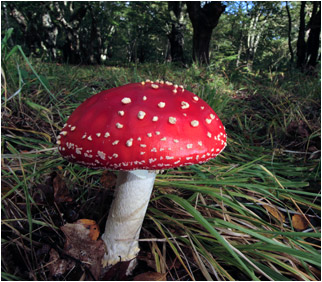 proved
impossible to cultivate. Occasionally the forest keepers patrol the area and I
have seen them catch once mushroom thief - he was let off with a warning but
looked highly embarassed. Fortunately the most photogenic mushroom, the bright red fly agaric
(right), is highly poisonous and they leave those alone.
proved
impossible to cultivate. Occasionally the forest keepers patrol the area and I
have seen them catch once mushroom thief - he was let off with a warning but
looked highly embarassed. Fortunately the most photogenic mushroom, the bright red fly agaric
(right), is highly poisonous and they leave those alone.
into the suburbs
Heading south from Chingford plain, the forest reaches several miles into London, but the roads and suburbs are closing in. A horse ride passes just west of Connaught Water and crosses Rangers Road. Starting from here it's possible to walk all the way to Wansted through the remaining fragments of forest. On the way there is Woodford Golf Club, the lake at Highams Park, and Hollow Pond.
There is another piece of forest just north of Epping, called Wintry Wood. There are some free-ranging farm animals kept here on the Wintry Wood smallholding, including goats, turkey, chicken and peacock. Also worth a visit are Knighton Wood and Lords Bushes in Buckhurst Hill. An ornamental pond was built in Knighton Wood, once the garden of a large house. The pond is a short walk down the path from the car park on Knighton Lane. In spring the rhododendrons here give the most colorful display in the forest.
Links
Visit the Friends of Epping Forest website for local news and events. I can only display a small selection of forest photos on this page, there are many more here.